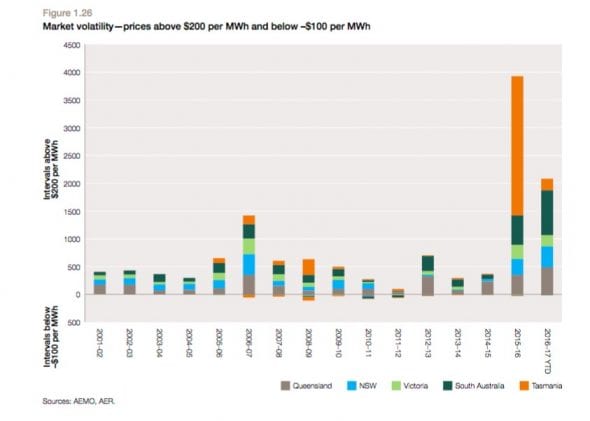by Giles Parkinson
The South Australian government’s official target for renewable energy is 50 per cent of local demand by 2025. According to the Australian Energy Regulator, it didn’t just reach that target in 2016/17, eight years early, it is literally blowing past it.
Data released in the AER’s state of the energy market report released last week suggests that the combined contribution of large scale wind power and rooftop solar PV has already reached 57 per cent in the first nine months of 2016/17.
The report showed that wind power accounted for 38 per of the state’s demand in 2015/16, jumped to about 43 per cent in calendar 2016, and then jumped even further in 2016/17 as new wind farms such as Snowtown and Hornsdale came on line.
“In the nine months to 31 March 2017, the contribution of wind generation was even greater, supplying 50 per cent of South Australia’s electricity,” the AER says.
Add in the at least 7.6 per cent contribution from rooftop solar – the AER report says that the 728MW of rooftop solar contributed 7.6 per cent of South Australia’s annual energy requirements in 2015–16 – that takes the state up to at leat 57 per cent for the nine months to the end of March.
That figure is expected to jump again as households and businesses continue to add rooftop solar, and as the third 109MW stage of the Hornsdale wind project comes on line.
Over the next year, the 220MW Bungala solar project and the 212MW Lincoln Gap wind farm, both near Port Augusta, will also come on line, taking the state up towards 65 per cent renewables, and there are numerous other projects said to be near the point of financial close.
As we reported in April, The Australian Energy Market Operator predicts that the state is heading towards 80 per cent renewable energy by 2021/22, saying that capacity of large scale renewables (wind and solar) will double to around 3,100MW over the next five years.
Popular content
Those additions could be affected, however, by the structure of the state’s proposed energy security target, and whether it allows wind and solar farms to be paired with battery storage, or whether its insistence on “real inertia) (i.e. from spinning turbines) results in curtailment of wind and solar.
AEMO also expects the amount of rooftop solar capacity in South Australia to double and reach over 1500 MW by 2025, by which time the state’s minimum demand could on occasions be met entirely by rooftop solar, suggesting the need for something smarter to happen with battery storage.
 Interestingly, the AER notes that the wild swings in prices often attributed to high renewable energy penetration are in fact being matched by states with rely almost exclusively on coal and gas.
Interestingly, the AER notes that the wild swings in prices often attributed to high renewable energy penetration are in fact being matched by states with rely almost exclusively on coal and gas.
This is because the prices are, in the end, set by the high price of gas-fired generation, and often manipulated when states have few major generators. Both South Australia and Queensland are dominated by just two or three major generation companies, and this is seen as a major cause of the problem
The AERs analysis shows that the most number of price spikes occurred in Tasmania in recent years, thanks to the failure of its Basslink cable, the drought that depleted its hydro resources and the subsequent reliance on fossil fuel generation.
The number of price spikes in South Australia and Queensland is roughly even, although the South Australia number is higher for the latest year after the work on the upgrade to the inter-connector to Victoria saw the gas generators in the state push prices to the maximum level on multiple occasions.
This article was originally published on the RenewEconomy website, and has been reprinted with permission.
This content is protected by copyright and may not be reused. If you want to cooperate with us and would like to reuse some of our content, please contact: editors@pv-magazine.com.


By submitting this form you agree to pv magazine using your data for the purposes of publishing your comment.
Your personal data will only be disclosed or otherwise transmitted to third parties for the purposes of spam filtering or if this is necessary for technical maintenance of the website. Any other transfer to third parties will not take place unless this is justified on the basis of applicable data protection regulations or if pv magazine is legally obliged to do so.
You may revoke this consent at any time with effect for the future, in which case your personal data will be deleted immediately. Otherwise, your data will be deleted if pv magazine has processed your request or the purpose of data storage is fulfilled.
Further information on data privacy can be found in our Data Protection Policy.